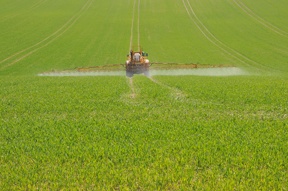 The pesticide known on the commercial market as Roundup is the subject of a new study published in the February 2016 issue of Environmental Health. In the study, 14 scientists raise new concerns over the health and environmental risks of the pesticide glyphosate. The pesticide is widely used on genetically modified (GMO) crops, which “were developed to be resistant to the effects of glyphosate, so the pesticide would kill the weeds, but not the plants.”
The pesticide known on the commercial market as Roundup is the subject of a new study published in the February 2016 issue of Environmental Health. In the study, 14 scientists raise new concerns over the health and environmental risks of the pesticide glyphosate. The pesticide is widely used on genetically modified (GMO) crops, which “were developed to be resistant to the effects of glyphosate, so the pesticide would kill the weeds, but not the plants.”
GMO crops were first approved in 1996, and since that time the use of glyphosate has grown nearly 15 fold. “Since the late 1970s, the volume of glyphosate-based herbicides (GBHs) applied has increased approximately 100-fold”
“In 2014 alone, the amount of glyphosate used was equivalent to 0.8 pounds per acre of cultivated cropland in the U.S.” Today, Roundup is the most widely applied pesticide in the world.
Another study published in Environmental Sciences Europe reported that since 1974, U.S. farmers have sprayed 1.8 million tons of glyphosate, and globally that number is 9.4 million tons.
Despite its popularity, the World Health Organization classified the pesticide as a possible human carcinogen in 2015, and it is not part of the USDA’s Pesticide Data Program, which measures pesticide residues on crops.” Because it’s not part of the program, consumers don’t know how much pesticide actually gets in the food. Recent tests have found significant amounts of pesticide residue on food samples, including a 2011 study that found glyphosate in “90.3% of 300 soybean samples.”
The study reported seven key conclusions about the pesticides, including the fact that its usage is on the rise.
- Worldwide, GBHs often contaminate drinking water sources, precipitation, and air, especially in agricultural regions;
- The half-life of glyphosate in water and soil is longer than previously recognized;
- Glyphosate and its metabolites are widely present in the global soybean supply
- Human exposures to GBHs are rising;
- Glyphosate is now authoritatively classified as a probable human carcinogen; and
- Regulatory estimates of tolerable daily intakes for glyphosate in the United States and European Union are based on outdated science.
In February 2016, the U.S. Food and Drug Administration confirmed that it would start testing for glyphosate residues on food later this year. The agency hasn't done so previously because of the cost and labor required to do the testing. France, the Netherlands, Denmark and Sweden have restricted the use of the pesticide while the U.S. EPA has actually increased the tolerance limits for exposure for certain foods. The Center for Food Safety said “50 times more glyphosate is allowed on corn grain now than was allowed in 1996.” The manufacturer of Roundup asserts that the pesticide is safe.
Pesticide residue laboratories are required to complete the analyses of an ever-increasing number of samples. The analyses typically involve use of multi-residue methods (both GC-MS and LC-MS) to test for over 500 pesticide residues. The QuEChERS extraction has become the method of choice for pesticides multi-residue analyses in a wide range of matrices because of its ease of use and proven robustness. Teledyne Tekmar Automate-Q40 automates the QuEChERS sample preparation workflow and helps to improve precision and accuracy of pesticide analysis.
